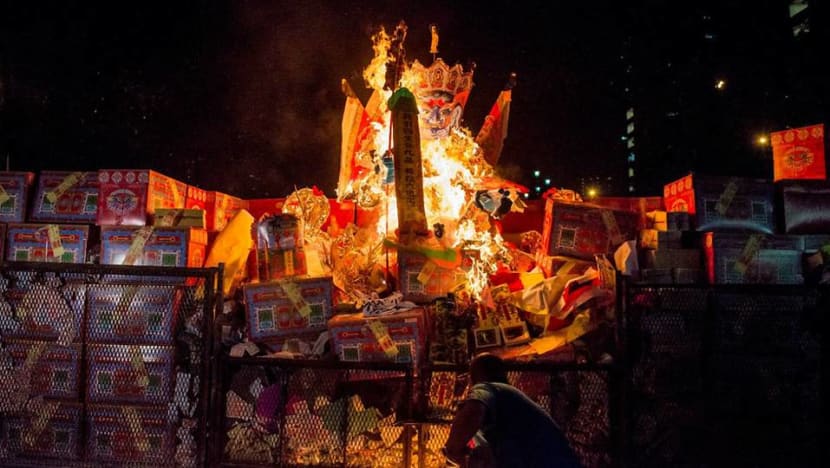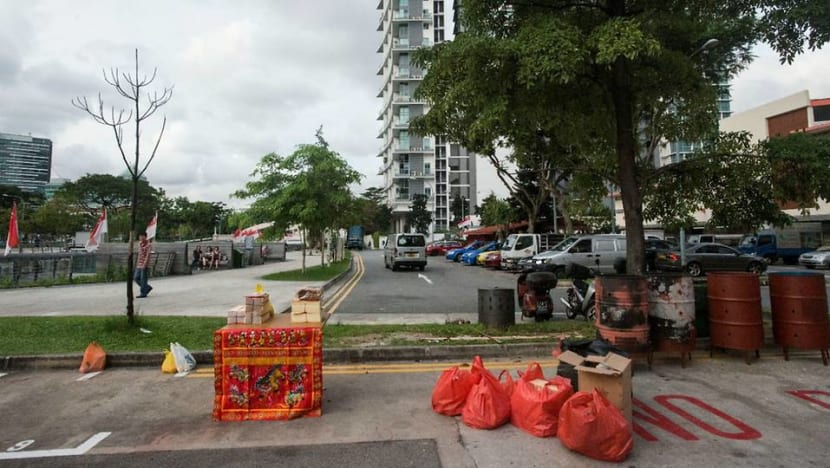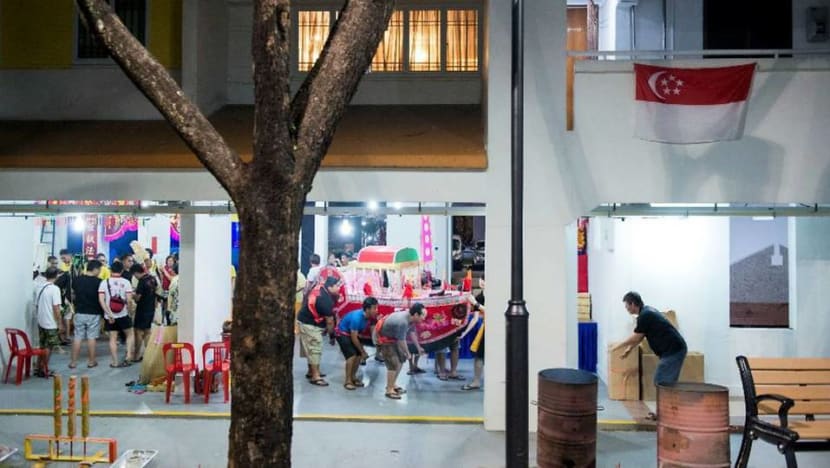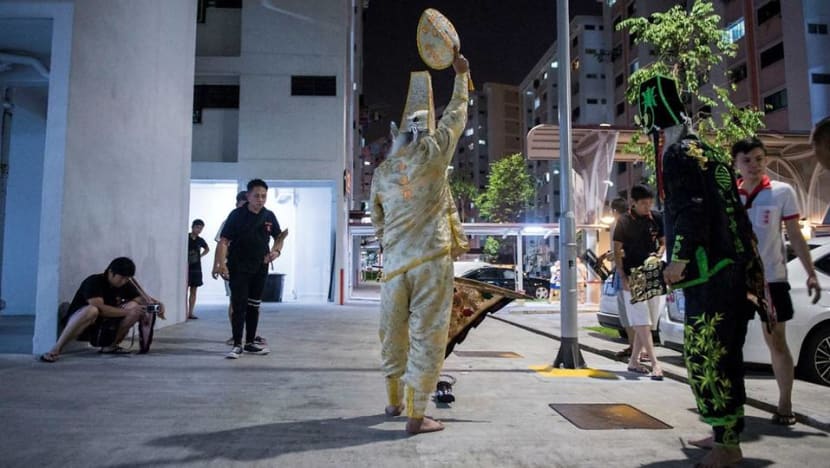commentary Commentary
Commentary: Finding filial duty, spiritual charity in Hungry Ghost Festival rituals
Roadside offerings spring up and people burn paper effigies. Terence Heng explores the deeper meaning behind these practices of the seventh month of the lunar calendar.

Returning Da Shi Ye, the King of Ghosts, to the underworld, completed through this paper effigy burning. (Photo: Terence Heng)
SINGAPORE: If you’re Chinese, or ascribe to Chinese beliefs, you know it’s that time of the year again.
You’ve probably already heard one or more of the usual advice from well-meaning relatives: Go home early, don’t buy a new flat, don’t hold a wedding, and if someone calls your name from behind, don’t turn around.
That last one would be particularly hard if your mother was asking for help to carry the groceries and you ran away. “Ah Boy, help!” “You’re not getting me this year she-demon!”
In Singapore, regardless of race, language or religion, you are also likely to have become highly adept at side-stepping various incense sticks, candles, food and wayward ashes on the street, on grass slopes, and near your favourite hawker centre.
Finally, if you live on the lower floors of an HDB estate, you probably have developed significant levels of tolerance for the copious amounts of smoke and ash that permeate the air.
EVERY SEVENTH LUNAR MONTH
The Hungry Ghost Festival is a religious and cultural event that happens on the seventh lunar month. Because of a quirk in the lunar calendar this year, we have had the sixth month repeat, so festivities have started a little later.
Exact beliefs vary from individual to individual and religion to religion, but the general idea is that the spirits of the dead are released from the underworld to roam the earth for a month.
During this period, the living and the dead intermingle, and the former are expected to care for the latter through offerings of food, drink, entertainment and money.
If these spirits are not cared for, there is a chance they could turn malicious and harm you. However, if you appease them, there is also a chance you might be blessed with good fortune in the form of winning 4D numbers, or a good business climate going forward.

As such, many Chinese individuals in Singapore, as well as the surrounding region, engage in a number of practices. First, there is a profusion of makeshift altars and roadside offerings, sometimes for wandering spirits (termed as “Good Brothers”), and sometimes for the spirits of one’s ancestors.
Secondly, individuals burn paper effigies of things needed by spirits to live their everyday lives. These include money, a passport to get out of the underworld, coloured paper symbolising cloth to make clothes, and sets of toiletries and other essential everyday items.
EXPRESSION OF IDENTITY AND FILIAL PIETY
Over the last five years, I have spent much of my time observing and photographing the Hungry Ghost Festival, from more mundane roadside offerings to larger, more organised events in Bukit Brown Cemetery and HDB estates.
Much of that work has focused on understanding the festival as a social process, in which different kinds of identities are expressed through material and performative cultures.
For instance, Hungry Ghost rituals and the presence of spirit mediums, particularly deities from the underworld, during the festival reveals, in part, many of our Chinese ancestors’ migratory journeys from China to Singapore, where Chinese folklore religion was particularly prominent. In a way, these represent slices of the cultural forms that our ancestors have carried over to Singapore, which continue to be shaped in the digital era.
But it is easy to dismiss much of these practices as mere superstition, historical or otherwise. And like many other things, that perception is exacerbated by social media and click-bait articles telling you about haunted spots and ghost stories.

What is less known is the tremendous amount of filial piety, personal sacrifice and devotion that some individuals and groups put into rituals. Rather than simply being about wandering spirits and the encounters the living have with them, the Hungry Ghost Festival is also about praying for the salvation or release from pain and affliction for one’s ancestors.
During this period, Buddhists take part in the Ullambana festival, commemorating the principle of filial piety. Ullambana recalls the story of the monk Maudgalyāyana who, unable to feed his tormented mother’s spirit in the underworld, consults Gautama Buddha who instructs him to care for the Sangha of the Ten Directions.
In doing good deeds, Maudgalyāyana was able to redeem his mother’s soul, releasing her from her punishment.
The Taoist version that some may be familiar with is the story of Mu Lian who descends into hell to save his mother.
Because of this, both Buddhists and Taoists practise salvation rituals for their ancestors. Calling it Chao Du, Taoists also lay out food and drink, and invite their ancestors to be preached to by priests, imploring them to let go of their anger so that they may be released from purgatory.
My research has also taken me into the homes of spirit mediums, particularly those with an affinity to the underworld deities. Most recently, I witnessed a Chao Du ritual that also included a ritual cleansing of an HDB block said to be afflicted with recent suicide cases.

Whether such cleansing is “effective” is not the point here – rather it is symbolic of the time and effort made by some of these individuals to make a better city for the living – a collective act of spiritual charity.
Like many religious practices in Singapore, the Hungry Ghost Festival is an amalgamation of many social, cultural and religious beliefs that have been, and continue to blend over time.
It is true that many superstitions permeate the activities that we witness and experience, but it is also true the same activities are intimately connected with Chinese diasporic histories, and like other festivals from other religions, add to the texture and fabric of our global city.
When the seventh month is over and the drums of hell money stop burning, we’ll breathe a little easier – both literally and metaphorically – and start loosening our belts for mooncakes for the mid-autumn festival.
But after that, keep an eye out in October for people dressed in white and carrying sedan chairs adorned with LED lights. It’s time for the Nine Emperor Gods Festival!
Terence Heng is an assistant professor at the Singapore Institute of Technology, where he studies the changing identities of Chinese Singaporeans through ritual and religion.














